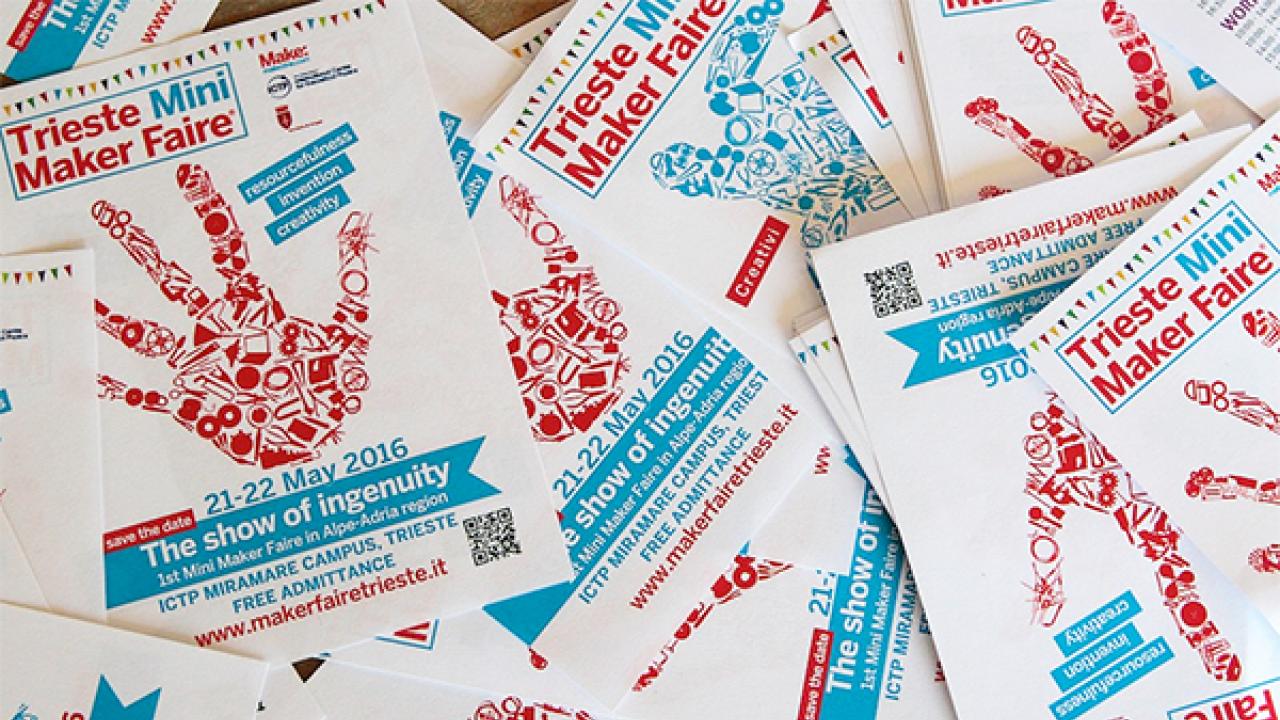
In May 2016, ICTP organized and hosted the third incarnation of the Trieste Mini Maker Faire (TSMMF), a successful weekend packed full of makers, creations, experiments, and curious visitors. Part of a worldwide network of Maker Faires, the TSMMF seeks to spur visitors to play with technology, to build things, and to remember that curiosity is fun. With an estimated 16,000 visitors in its third year, it was quite a successful event.
See photos from the events on ICTP's Flickr page
This year, TSMMF co-organizers Enrique Canessa and Carlo Fonda of ICTP’s Science Dissemination Unit (SDU) and SciFabLab added a second event to the festivities for the first time. The Friday before the weekend of the Maker Faire, a Science Picnic was held for students of all ages. Its focus was different from the Maker Faire: scientists and volunteers presented hands-on experiments and demonstrations, focusing more on basic science concepts instead of technology.
"We were expecting no more than 500 visitors at the Science Picnic," says Fonda, but over 2,000 students from schools throughout the region visited for a wide variety of programs, such as 'Light and color' and 'Illusions and deceptions: a challenge between mind and reality.' Older students went to sessions like '(Dis)Information on renewable energies', 'Meeting the two souls of a laser: light-particle and light-wave', and 'Exploring the surprising way quantum objects move'.
Many of the programs were provided by university students, who organized specifically for the Science Picnic and plan to continue their science communication efforts. Canessa and Fonda would like to see all the scientific institutions in Trieste collaborate to co-host a bigger Science Picnic in the future, as an interactive look at all of the science going on in the region. For both Canessa and Fonda, the motivation to add the Science Picnic this year was to simply show that science is not only dry facts in textbooks. "Even if they don't learn any science," says Fonda, "if they only learn that science is fun, that is enough."
The Mini Maker Faire followed on Saturday and Sunday, aiming to gather people who, in their spare time, invent, build, and tinker with all sorts of technology and materials, whether with a specific goal or just for fun. Where craftspeople usually use traditional skills and inventors come up with original ideas, makers typically apply or recycle existing technologies for new purposes, building inexpensive devices themselves. These makers come to demonstrate the projects progressing in their basements or that they have turned into start-up companies or non-profits.
This year, the makers demonstrated lasers, robots of many designs, drone prototypes, 3D-printed sculptures, methods for recycling, 3D-printed prosthetics, and many more projects. In total, 104 projects were exhibited, with more than 300 makers there to take people on tours of their ideas. The Trieste Mini Maker Faire was independently organized under license from Maker Media, Inc. "The idea of a maker faire is that it's not a single event, it's a container for many events," explains Fonda, listing the variety of events that happened within this year's faire: the robot competition, the science shows, the LHC particle physics simulator in collaboration with CERN.
The mission of ICTP's SciFabLab, the year-round home of the two TSMMF organizers, includes three goals: using 3D printing and making for science, education, and sustainable development. "We want this interaction between science and society," explains Canessa. The TSMMF aims to build this sort of bridge. One of the ways it does, and also differs from other maker faires, is that it's free: no entrance fee is charged for visitors. A lot of support is also offered to the makers who come to share, including food and accommodation for the weekend. "We tell the volunteers, support the makers, help them out, and they will have good enthusiasm for interacting with the public," says Fonda.
The mission of the TSMMF extends into the SciFabLab and ICTP's overall mission: to build scientific and human capacity in developing countries. "One of the problems I have perceived in developing countries is when we send them equipment, they don't touch it because they are afraid of breaking it. They have the technical skills, but it's a psychological barrier," says Fonda. "It is important to break this wall, so a maker faire is valuable because it shows people, especially young people, that they should play with technology, they should free their creativity and try things."
This mission moved one of the makers to incredible generosity. Andrea Martini of Robot Factory S.R.L. wanted to help further ICTP’s mission however he could, and since he runs a 3D-printer company, he graciously donated a 3D printer and an electroplating machine to ICTP's SciFabLab. After a public announcement during the Maker Faire and a visit with the printer three weeks later, his generosity is well on its way to helping makers create sophisticated projects.
"We want people to walk away with a sense that they can do something like this themselves," Fonda says. "Everyone--from the smallest children to the older people--should understand that they are also able to do this, because they see people like themselves doing crazy stuff, not scientists and not special people, but people like them." The goal is to extend this sense of building and experimenting at home to developing countries, explains Canessa, but also to help incorporate ICTP into the surrounding local community and give back for their support. "It's a fiesta of creativity," he says.
--Kelsey Calhoun
NOTE: More photos from the TSMMF are available here.
















